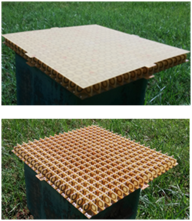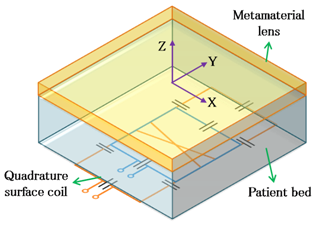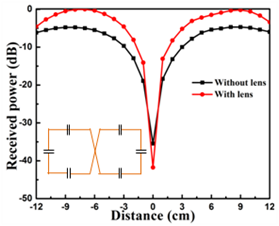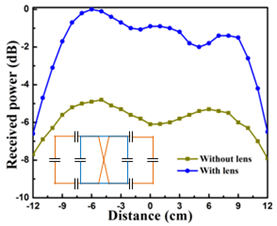1707
Sensitivity Improvement of Quadrature Surface Coil using Isotropic Metamaterial Flat LensTejkiran A. Patil1, A. Sidhique1, Pulkit Sharma1, Rajesh Harsh1, and P. H. Rao2
1Indigenous Magnetic Resonance Imaging Laboratory, SAMEER, Mumbai, India, 2SAMEER-CEM, Chennai, India
Synopsis
Metamaterial lens has previously been used to improve the sensitivity of phased array coils and the improvement is specifically seen at the epicenters of the loops and a sharper notch is formed at the critical overlapping region because of high resolving capability of the lens and it is not desirable for larger field of view (FOV). This work proposed a novel concept of nearly constant improvement in receiver sensitivity over the FOV using a combination of both metamaterial flat lens and quadrature surface coil.
Introduction
An isotropic negative-permeability metamaterial flat lens has previously been used to improve the sensitivity of surface coils, leading to an improvement in image quality [1]-[3]. Similar configurations of metamaterial lenses have been investigated for Body Phased Array Coils [4]. Improvement of SNR in phased array coils by the application of a metamaterial flat lens, is specifically seen at the epicenters of the loop(s)- because of the high resolving capability of the lens. Separately, the use of quadrature detection has also been proposed for increasing receiver sensitivity by a factor of [5]. The work in [6] also shows that a quadrature MRI receiver coil can improve SNR, even when compared to phased array coils of the same coverage. Here we demonstrate the improvement in receiver sensitivity using a combination of both the metamaterial flat lens and quadrature detection techniques, using a baseline case of a butterfly coil. The metamaterial flat lens loaded quadrature surface coil exhibits nearly constant and improved sensitivity throughout the field of view.Methods
A quadrature surface coil operating at 63.87 MHz for 1.5T MR imager is developed for minimum coupling using the Critical Overlapping, and further improved using the Preamplifier Decoupling Methods [7].The signal received from the coils is routed to a quadrature hybrid combiner and power measurement is carried out using a spectrum analyzer. An isotropic negative permeability metamaterial flat lens consists of periodic structures of capacitor loaded split-rings arranged in a cubic fashion [3]. The lens was fabricated for the same operating frequency (63.87 MHz) and is shown in Figure 1. Its focusing ability was successfully tested with the surface coil. Subsequently, the flat lens was integrated within the patient bed, placed atop the quadrature surface coil as depicted in Figure 2. The power measurements – for quantification of receiver sensitivity –were performed with a) baseline of butterfly coil only, b) butterfly coil with the metamaterial flat lens, c) butterfly coil and the loop coil (collectively termed as the Quadrature Surface Coil), and d) Quadrature Surface Coil and the metamaterial flat lens. A magnetic loop was used as a transmitter in all these cases, placed at a depth of 2.3 cm above the patient bed (for a separation of 9.6 cm between the magnetic loop and the plane of the surface coil).Results and Discussions
The received power response of the butterfly coil along Y-direction, is shown in Figure 3. It is almost flat through the entire region of coverage, except at the central regions, where a deep notch is observed. The metamaterial flat lens loaded butterfly coil showed maximal increase in sensitivity near the loop-epicenters with a deeper, and sharper attenuation of the notch. Figure 4 shows the comparative study of the received signal power analysis of quadrature surface coil with and without flat lens. The sensitivity of the plateau regions near the loop-epicenters was increased by around 5 dB, while the attenuation at the center was also greater by around 5 dB after metamaterial flat lens loading. The measured received power from the quadrature surface coil shows almost flat response. This too is in accordance with the predictions of the theory: the new flux-pick up element (square loop coil) picks up the flux at the centre and this is then added to the butterfly coil pick-up via the hybrid combiner. The metamaterial flat lens loaded quadrature surface coil shows around 5 dB improvement in received power over the field of view and even at the center as shown in Figure 4.The improvement at the center is due to the ability of lens to resolve the added magnetic pick-up element.Conclusions
A quadrature surface coil with a metamaterial flat lens was fabricated and tested. The received signal power was found to have been improved by 4-5 dB over the field of view. This could manifest as an improvement in SNR and hence the image quality. The proposed metamaterial flat lens loaded quadrature surface coil find applications in spine imaging.


